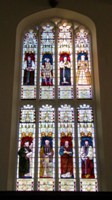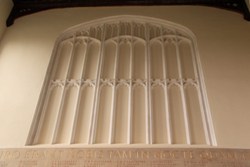The windows of Trinity College Chapel
The original windows of the Chapel were glazed in 1567 with white glass bearing  inscriptions, coats of arms, and heraldic badges such as the fleur-de-lys, portcullis and rose.
inscriptions, coats of arms, and heraldic badges such as the fleur-de-lys, portcullis and rose.
The present window glass in the Chapel is mid-Victorian (1871-5). The designs were elaborated on a scheme of religious and historical allegory devised by B.F. Westcott and F.J.A. Hort, both distinguished Trinity theologians. The work was designed by the Pre-Raphaelite artist Henry Holiday RA (1839-1927). Many of the faces of the great figures of the Church are portraits of eminent Victorians.
The scheme of the design is somewhat recondite: advancing from east to west, the windows represent the historical development of the course of Christian life, gradually confined within narrower limits until it finishes with the representatives of the College. The figures in the different periods were chosen to represent characteristic features or movements of the time in which they lived. For instance, in the window illustrating Latin Christianity (North side, IV), Charlemagne represents empire; Dante represents medieval thought; St Columban – missions; Pope Gregory VII – ecclesiastical organization; St Francis – devout life; and Giotto – art.
Click on each title for detail of the individual windows. You can also search for the subjects depicted in the memorials index.
NORTH SIDE (East to West) |
SOUTH SIDE (East to West) |
||
| I | Disciples of Christ | I | Evangelists and teachers |
| II | The Ante-Nicene Church | II | The Church of the first days |
| III | The Western Church | III | The Eastern Church |
| IV | Latin Christianity | IV | The Anglo-Saxon Church |
| V | English ecclesiastical life before the Reformation | V | English national life before the Reformation |
| VI | Founders and benefactors of the University and College | VI | The English Reformation |
| VII | University and College worthies | VII | Worthies of Trinity College (and elsewhere) |
| VIII | Worthies of Trinity College | ||
 The great east window has been bricked up since 1706. A proposal was made in 1867 to re-open the window and fill it with stained glass, but this was rejected. The Victorian stained glass windows in the Ante-Chapel, which depicted scenes from the New Testament, were removed in 1948-49.
The great east window has been bricked up since 1706. A proposal was made in 1867 to re-open the window and fill it with stained glass, but this was rejected. The Victorian stained glass windows in the Ante-Chapel, which depicted scenes from the New Testament, were removed in 1948-49.
The west window was blocked up in the early seventeenth century, owing to the removal of King Edward’s Tower to its present position. It was reopened on the inside, to display the tracery, in 1875.
